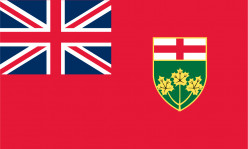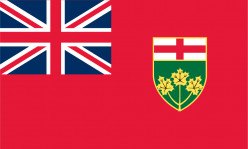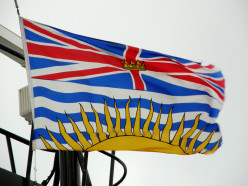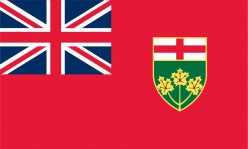 73
73- 0
Visiting Armadale, Toronto, Ontario: A Free Methodist Building Dating from 1880
What is reputedly the oldest continuously functioning Free Methodist building in Canada is situated in the former hamlet of Armadale, now part of the City of Toronto, Ontario. This historic site is situated close to Milliken Park.
- 0
Visiting Brougham, Pickering, Ontario: Italianate Style at Bentley House, Dating From the 1850s
Built for William Bentley in 1853-55, this Italianate building — a Recognized Federal Heritage Building — in Brougham, Pickering, Ontario was inhabited by members of the same family for over a century.
- 0
Visiting a Place of Green Maturity and Seclusion in Washington State: Lincoln Park, Blaine
With its massive trees stretching heavenward — typical of the Pacific West Coast — Lincoln Park helps to make Blaine, Washington State a place at which to stay and spend time exploring, and not simply a place of transit.
- 0
Visiting Comines, France: A Belfry Keeping Watch Over the Lys River Since the Middle Ages in the Heart of Flanders
Flemish belfries, including the looming structure at Comines, France, close to the Franco-Belgian border, can at times seem strongly to evoke the idea of a silent sentinel.
- 0
Visiting Pointe Saint-Charles, Montreal, Quebec: Le Pont Victoria / Victoria Bridge — 19th Century Triumphs & Tragedies
Extreme triumph and extreme tragedy: though poles apart, they met at Le Pont Victoria / Victoria Bridge at a crossing — completed in 1859 — over the Saint-Laurent / Saint Lawrence at Montreal, Quebec.
- 0
Visiting Ventimiglia, Italy, Overlooked by Its Medieval Cathedral Tower: Reaching for the Sky & Subterranean Rumblings
The Cathedral at Ventimiglia, Italy, is set conspicuously upon a hill overlooking the city; its history and associations are set deep in obscure allusions.
- 0
Visiting the Lanesborough Hotel: Commemorating a Republic of Ireland Town in the Heart of London, England
The Lanesborough Hotel, in Central London, England, commemorates, through the name of a family which was formerly prominent socially, a vibrant town in the Republic of Ireland. It lies a fairly short walking distance from the Embassy of Ireland.
- 0
Visiting Glanmore House, Belleville, Ontario: Recalling the Curious Historiography of Prime Minister Bowell of Canada
A National History Site of Canada, with nationally acclaimed Second Empire architecture; it contains artifacts including the Sir Mackenzie Bowell Collection, named for a 19th century Prime Minister of Canada whom — oddly — Canadians have seemingly spared no effort to try to forget.
- 0
Visiting Front Street, Ketchikan, Alaska: A Carved Eagle by Nathan Jackson Recalling the Tlingit Language City Name
Carved by Nathan Jackson, this eagle on display in Front Street, Ketchikan, Alaska is the embodiment of the name of the City in the Tlingit language.
- 0
Visiting Leicester Square, London, England: An Historic Greening of a Hogarthian Locale
Mature London plane trees provide a canopy for Leicester Square, in the heart of the English capital. Its history provides memories of the heights and depths of achievement and even excess.
- 0
Visiting Parsippany-Troy Hills: A Crossroads of New Jersey With a Submerged, Rich History
A crossroads in a state long known as the Crossroads of the American Revolution, New Jersey's Parsippany-Troy Hills Township encapsulates a strong historic sense of transition.
- 0
Visiting Avenue De La Liberté, Luxembourg City: A Leading Thoroughfare in the Grand Duchy — What's in a Name?
Once known as Avenue Adolphe, this important thoroughfare in Luxembourg City has been known since 1925 (with a break in World War Two) as Avenue de la Liberté; these names reflect historical developments in the Grand Duchy.
- 0
Visiting the 1911 Bank of Toronto Building, The Junction, Toronto, Ontario: Classical Revival Style by Eustace Bird
An ornate building, formerly belonging to the Bank of Toronto (amalgamated in 1955 with the Dominion Bank) is located at Dundas Street West's intersection with Keele Street, in the Toronto, Ontario suburb of The Junction. The building, dating from 1911, was designed by Eustace Bird (1870-1950).
- 2
Visiting An Unusually Shaped, Italianate Church Building, Soho Square, London, England: St. Patrick's, Dating From 1893
Noted for extensive catacombs, St. Patrick's Church, facing Soho Square Gardens, London, England, dates from 1893, the work of John Kelly. It is noted for a number of interesting features, including its unusual, elongated shape and its conspicuous tower. It has a strong musical tradition.
- 1
Visiting the Wesertalsperre, Belgium: Scenically Artificial, and the Endless Riddle of Elusive Referents in Belgium
Inaugurated in 1950, the reservoir area known in German — the local, official language — as the Wesertalsperre is a focus for healthy, outdoor activities; it also may be said to recall obliquely the institutional fluidities of contemporaneous developments in Belgium.
- 0
Visiting the Former Victoria Presbyterian Church, The Junction, Toronto, Ontario: Romanesque Revival Style From 1891
The building of the former Victoria Presbyterian Church, in Romanesque Revival Style, was completed in 1891 and was designed by Messrs. Knox and Elliot. Its history reflects a former influx of immigrants to the suburb of West Toronto Junction, formerly a separate jurisdiction from Toronto.
- 0
Visiting Sir Aston Webb's Terracotta Building, Overlooking Soho Square, London, England: The French Protestant Church
With an imposing frontage and a small octagonal tower, the French Protestant Church in London overlooks Soho Square. Executed in terracotta to the design of Sir Aston Webb (1849-1930), the building was completed in 1893. The congregation itself dates from 1550, founded under the reign of Edward VI.
- 0
Visiting the Gardens of Kasteel Eijsden, Limburg, The Netherlands: Peaceful and Tumultuous, Historic Water Boundaries
The grounds of Kasteel Eijsden in Limburg, The Netherlands, contain mature landscaping and make for peaceful scenes close to the Maas and Voer rivers, while these rivers have some tumultuous, historical associations.
- 0
Visiting the Campbell Block, The Junction, Toronto, Ontario: Ornate Building Formerly Housing a Hotel, Dating From 1888
The Campbell Block, at The Junction, Toronto, Ontario, dates from 1888. Recently restored, the building, designed by James A. Ellis, exhibits some Romanesque styling and is of historical significance in the development of the neighbourhood.
- 0
Visiting Soho Square, With Its Market Cross Building Centrepiece: Nuanced, Tudor Revival Heritage in London, England
In Soho Square, London, England, its market cross centrepiece is a heritage building dating from 1926, in Tudor Revival style.
- 0
Visiting Maison Bryson / Bryson House, Mansfield-et-Pontefract, Quebec: Historic Building Dating From 1854
Maison Bryson / Bryson House, dating from 1854, at Mansfield-et-Pontefract, in the Municipalité régionale de comté de Pontiac / Pontiac Regional County Municipality, within Quebec's Outaouais region, significantly encapsulates the history of the Pontiac region.
- 0
Visiting the Annette Street Public Library, The Junction, Toronto, Ontario: 1909 Beaux-Arts Building by Ellis & Connery
Endowed by the Carnegie Foundation, Annette Street Public Library, The Junction, Toronto, Ontario, dates as a structure in Beaux-Arts style from 1909. Its origins lie in a Mechanics' Institute library founded nearby in 1888.
- 0
Visiting Mount Pleasant: A Hilly Suburb, Making Vancouver, British Columbia, Breathtaking in More Ways Than One
With good views of Downtown Vancouver, British Columbia, Mount Pleasant has some very steep gradients, so walkers: be warned...!
- 0
Visiting L’Île-du-Grand-Calumet, Quebec: An Octagonal Tower on an Island in the Rivière Des Outaouais / Ottawa River
L'Île-du-Grand-Calumet is both an island and a municipality situated in the Rivière de l'Outaouais / Ottawa River; a noted feature is a 19th century, Gothic-styled church building with an octagonal tower.
- 2
Visiting Thorneycreek at Bin Brook, Robinson College, Cambridge, England: Arts and Crafts Building Dating From 1895
At Robinson College, Cambridge, on Bin Brook, Thorneycreek is an Arts and Crafts building dating from 1895. The College grounds give a strong sense of tranquility and seclusion.
- 0
Visiting Alexandria, Ontario: With its Main Street Dominated by a Conspicuous Spire
Main Street, at Alexandria, Ontario is dominated by the spire of the Paroisse de Sacré-Coeur. The village is located in the Stormont, Dundas and Glengarry United Counties. Locally, the population is about 50% Francophone.
- 0
Visiting La Ferme / The Farm, Gatineau, Quebec: Linked With W. L. Mackenzie King & the Speaker of the House of Commons
A property with a somewhat elusive past and identity — influenced by a rather unusual man, Prime Minister of Canada William Lyon Mackenzie King (1874-1950) — la Ferme / The Farm is today the official residence of the Speaker of the Canadian House of Commons.
- 0
Visiting Airdrie, Alberta: Canada's Highest City, A Place of Dynamism, Remembering the Past
Geographically, Nose Creek has long been central to the rising fortunes of Airdrie, a small city close to Calgary, Alberta. Airdrie is known as Canada's highest city, given its proximity to the Rockies.
- 0
Visting the Admiralty Arch, London, England: By Sir Aston Webb, 1910, the First Sea Lord's Former Official Residence
Designed by Aston Webb and completed in 1910, the imposing Admiralty Arch, close to London's Trafalgar Square, The Mall and Whitehall, was once the official residence of First Sea Lord The Earl Mountbatten.
- 0
Visiting Sainte-Justine-de-Newton: An Octagonal Tower at a Church Building Dating From 1866
Strongly Francophone in character, and with a conspicuous parish church building — dating from 1866 — characterized by an octagonal tower, Sainte-Justine-de-Newton was formerly influenced by a Scottish settlers and was never organized according to the French seigneurie system.
- 0
Visiting Victoria Street, Tweed, Ontario: Century Old Frontages With Ornate Cornices
At Tweed, Ontario, Victoria Street has many properties with ornate cornices, recalling life at a small, Ontario town 100 years ago.
- 1
Visiting the Harbour at Ketchikan, Alaska: A Seaplane Base Vital for Communications to Isolated Communities
Seaplanes, based at Ketchikam Alaska, are both a vital lifeline to isolated Alaskan communities and also the means of tours to the Misty Fiords National Monument. Statistics shoq no less than 51 seaplanes based at Ketchikan Seaplane Based.
- 0
Visiting A Former Station With Ornate Features, at Témiscaming, Quebec: Dating From 1927
Quebec's Gare de Témiscaming / Témiscaming Station dates from 1927 and has some ornate features. It is now an historic monument and houses a museum, with strengths in the history of immigration to western Quebec.
- 1
Visiting the Former Jailhouse, Tweed, Ontario: Dating From 1898, Claimed as the Smallest in North America
Tweed, Ontario, has a small Jailhouse — said to be North America's smallest — dating from 1898, which had to close in 1950 for lack of a 'clientele'...
- 0
Visiting the Grandest of Grand Entries: The Uniqueness of Ketchikan, Alaska's First City
The juxtaposition of snow capped mountains and a bustling Downtown area at Ketchikan gives honest meaning to the word 'unique', here, at Alaska's First City.
- 0
Visiting Norway Bay, Bristol, Quebec: Seemingly Defined by Both a Curious Stillness and a Sense of Transition
Norway Bay, in Quebec's Bristol municipality, in Outaouais, has long had a transient population; it was formerly linked across the Rivière des Outaouais / Ottawa River to Ontario by a regular ferry.
- 0
Visiting the Église Saint-Vincent: A Domed Presence Looming Over the Meuse River at Liège, Belgium, by Robert Toussaint
The domed Église Saint-Vincent at Liège, Belgium dates from 1930, the work of architect Robert Toussaint. It variously exhibits Neo-Byzantine, Art Deco and Modernist styles. Its proximity to the Meuse River makes it a memorable footfall in the consciousness of visitors to the city.
- 0
Visiting the Renfrew County Courthouse: Pre-Confederation Neo-Classicism by Henry Horsey
Dating from 1862-1866, the Renfrew County Courthouse was designed by Architect Henry Hodge Horsey (1830-1911), and executed in limestone quarried in Canada-Est / Canada East (Quebec), in Neo-Classical style.
- 0
Visiting the Manège Militaire Salaberry / Salaberry Armoury, Gatineau, Quebec: A Francophone Military Figure Remembered
The Manège Militaire Salaberry / Salaberry Armoury, Gatineau, Quebec, dates from 1938, the work of Architect Lucien Sarra-Bournet (1896-1992). It is named for Charles-Michel d'Irumberry de Salaberry (1778-1829), who served with distinction at the Battle of Chateaugauay, 1813.
- 1
Visiting Calais, France: Memories Blowing in the Wind at the Jetée de l'Ouest
Calm as a millpond — seemingly sometimes — but the rough weather off the port of Calais, France is a constant down the centuries.
- 2
Visiting Mithras House, Brighton: Dating From 1939, With Art Deco Features, Some History at the University of Brighton
One of the University of Brighton's main buildings is Mithras House, overlooking Lewes Road, Brighton, East Sussex, England. The structure dates from 1939. The University was chartered in 1992, but its origins lie in a School of Art founded in 1858 at the Royal Pavilion.
- 0
Visiting the Pontiac Region's Pont Félix-Gabriel-Marchand, Dating From 1898: A Bridge Named for a Quebec Prime Minister
This covered bridge in Municipalité régionale de comté de Pontiac / Pontiac Regional County Municipality, named for a Quebec Premier, dates from 1898 and is the longest of its kind in Quebec.
- 0
Visiting Audun-le-Tiche, France: Lush Greening and Clean Waters Close to the Grand Duchy of Luxembourg
Audus-le-Tiche, in eastern France, exhibits lush transformations at a former industrial site.
- 0
Visiting Pembroke, Ontario: A Solid City Hall Dating from 1889
Designed by architect Thomas Fuller (1823-1898), Pembroke's City Hall dates from 1889. It formerly served as a post office until 1958.
- 0
Visiting Chapeau, Quebec: Scarcely Perceptible Subtleties Looming Over the Rivière-des-Outaouais / Ottawa River
Chapeau is a village in l'Isle-aux-Allumettes, Quebec; its situation gives rise to a number of intriguing anomalies.
- 1
Visiting the Cardston Alberta Temple: 1913 - 1923 Monumental Architecture by the Rockies, at Cardston, Alberta
The imposing Cardston Alberta Temple dates from 1913-1923. The work of Pope and Burton architectural partnership of Salt Lake City, its profile has the Rockies as a striking backdrop.
- 0
Visiting the Capilla Jackson, Montevideo: Gothic Lines, Shadows and Memories of a Prominent Uruguayan Extended Family
Strongly Gothic features characterize this building in Montevideo, Uruguay, dating from 1870, and designed by French architect Victor Rabú (1834-1917). It is named for an historically prominent Uruguayan family.
- 0
Visiting Rapides-des-Joachims, Quebec: Isolated Community Recalling Edgar Rice Burroughs?
At this peaceful Quebec village on the Rivière des Outaouais / Ottawa River time and isolation are seemingly telescoped. Visitors will maybe spot...eagles.
- 0
Visiting the Grover-Nicholls House, Peterborough, Ontario: Greek Revival Building Dating From Circa 1847
The design of this Greek Revival building, in Peterborough, Ontario almost recalls New England rather than pre-Confederation Canada West. Built circa 1847, it is thought to follow a design by Minard Lafever dating from 1833
- 0
Visiting 3 Cleveland Row, London, SW1, England: Frank T. Verity's 'Maisons De Luxe'-Style Building, Completed in 1906
3 Cleveland Row, London, SW1, close to St. James's Place, has an interesting history; its 'Maisons de luxe' features by Architect Frank T. Verity form the frontage to the Sudanese Embassy.
- 0
Visiting Dorval, Quebec: What's in a Name? Reflections on the Past and the Future
When one studies some linguistic features of Dorval, on Île de Montréal / Montreal Island, Quebec, historical complexities emerge.
- 0
Visiting the 1879 Church of the Redeemer, Toronto, Ontario: Continuities and Changes at Bloor Street and Avenue Road
The original site of the 1879 Church of the Redeemer at the intersection of Bloor Street and Avenue Road in Downtown Toronto, Ontario has changed beyond recognition but the stone features of this Neo-Gothic building are virtually identical.
- 2
Visiting Southwark Cathedral, London: Gothic and Neo-Gothic Structure Dating From the 12th to the 19th Centuries
The main Gothic parts of Southwark Cathedral, London, date from 1220 until 1440, with 19th century restoration, particularly in the nave. Today the building is a widely used venue for many events.
- 0
Visiting Paris-Gallieni Station, Bagnolet, France and the Nearby Parc de Bagnolet: Arrivals and Homecomings
Bagnolet, on the outskirts of Paris, France, is the first locality in the region of the French capital at which many international travellers arrive. Its international and multicultural character is far from limited to those for whom it is a place of transit.
- 0
Visiting the Waterfront Place Amphitheatre Cascade, Vancouver, British Columbia: A Living, Neo-Vorticist Sculpture?
The Amphitheatre Cascade Fountain at Waterfront Place in Vancouver, British Columbia, seems to combine ancient and modern design ideas.
- 2
Visiting the 1861 Metropolitan (Spurgeon's) Tabernacle, Elephant and Castle, London, England: By William W. Pocock
The Metropolitan (Spurgeon's) Tabernace at Elephant and Castle, London, England, was designed in Neoclassical style by William W. Pocock, and completed in 1861. Four towers which were part of Architect Pocock's original design, were never built. The building was restored after WW2 bomb damage.
- 0
Visiting Gatineau: Panoramic Views of Quebec's Fourth City
Some of the best views of Gatineau, Quebec are to be obtained from the Ottawa, Ontario side of the Rivière des Outaouais / Ottawa River; the distinctions between the two sides of the River should, however, never be forgotten.
- 0
Visiting St. Alphonsus Church, St. Clair Avenue, Toronto, Ontario: A Statement in Neo-Gothic, Dating From 1911
As a building, St. Alponsus Church, on St. Clair Avenue, Toronto, Ontario, dates from 1911; it was previously used by Presbyterians and by the United Church. Its features are strongly Neo-Gothic.
- 2
Visiting London South Bank University, Elephant and Castle, London, England: A Well Established Seat of Learning
In England's London Borough of Southwark is London South Bank University, a now mature seat of learning with its origins in the 19th century; a short travelling distance from its site at Elephant and Castle are various cultural and architectural visitor attractions.
- 0
Visiting Givet, and Its Quayside: Seemingly Unique Character Elements of a Town at an Extremity of Northern France
Something of the history of France and of the town of Givet, at a northern extremity of French territory, can be taken in at a glance from the quayside, beside the historic Meuse River, known to the Romans as the Mosa.
- 0
Visiting St. Volodymyr's Ukrainian Orthodox Cathedral, Toronto, Ontario: A Byzantine Revival Structure Dating From 1946
Three domes are a very visible part of the profile of St. Volodymyr's Eastern Orthodox Cathedral, in Toronto, Ontario, dating from 1946.
- 0
Visiting the Former Charing Cross Hotel, London, England: By Edward Barry, Completed in 1865, With a Fine Frontage
The former Charing Cross Hotel building in a central London, England location, close to Trafalgar Square, is often overlooked; but its fine features date from 1865, the work of architect Charles Barry, from a distinguished family of building designers.
- 0
Visiting Reuler: Typical Oesling Topography in the Geographically Very Varied Grand Duchy of Luxembourg
History and topography can be deeply intertwined in northern Luxembourg; time spent years ago in an Oesling region locality is — perhaps subjectively — recalled.
- 0
Visiting Ermatinger House, Sault-Ste-Marie, Ontario: Dating From 1814/1823, Part of a National Historic Site of Canada
Named for a somewhat enigmatic fur trader, this stone building dates from 1814/1823, and forms part of a National Historic Site of Canada.
- 0
Visiting Orange Street Chapel, St. James's, London, England: With a Neoclassical Pediment, Founded in 1787; Rebuilt 1929
Orange Street Chapel, London, England, was founded as a Congregational church in 1787; the current structure dates from 1929, featuring a Neoclassical pediment; the site has a number of interesting, historical associations.
- 0
Visiting Pointe Saint-Charles, Montreal, Quebec: A Skyline Dominated by the Twin Towers of the Église Saint-Charles
The twin towers of the Église Saint-Charles are very conspicuous at the Pointe Saint-Charles neighbourhood of Montreal, Quebec. Dating from 1914, the building replaced a previous structure destroyed by fire.
- 0
Visiting Scenic Lake Nipissing at North Bay, Ontario: Gateway of the North
Scenic — and historically at times tragic — Lake Nipissing has played a major role in defining the character of the Northern Ontario city of North Bay.
- 2
Visiting Leicester's Station, England: Ornate Structure by Charles Trubshaw, With Fine Brickwork, Completed 1894
Completed in 1894, Charles Trubshaw's Leicester Station incorporated red brickwork and many arches in its striking design.
- 0
Visiting Saint-Joachim, Quebec: A Church Building Dating From 1779
The Église de Saint-Joachim, in a village of the same name, north of Quebec City, dates from 1779, the scene of poignant, historic events.
- 0
Visiting Eldon House, London, Ontario: Dating from 1834, Fine Architectural Heritage Named for a Reactionary Jurist
With its gardens, Eldon House, London, Ontario, is a fine piece of architectural and historical heritage; it was named for a jurist with a reactionary reputation who opposed the 1832 Reform Bill.
- 0
Visiting Victoria Park, Widnes, England: Scenic Area Reflecting Over a Century of British History
Widnes's Victoria Park is a well regarded facility which provides a cameo of Great Britain's past at this Northern England town.
- 0
Visiting Tourcoing, France: At Avenue Gustave-Dron, Remembering a Long-Serving Mayor at a Grand Approach to the Station
A brief look at the life and times of Gustave Dron (1856-1930), a long serving Mayor of Tourcoing, provides a window on the history of this major French city and of France.
- 0
Visiting Toronto, Ontario: Fine Views of F.W. Cumberland's University College National Historic Site of Canada, 1856/59
Dating from 1856/59, F. W. Cumberland's University College, Toronto exhibits Romanesque Revival style. The College was the result of Provincial preferences for funding non-denominational higher education; many graduates of the College have been highly distinguished.
- 0
Visiting St. James the Great Church, Cardiff, Wales: Imposing Spired Building by E. M. Bruce Vaughan, Completed in 1894
E. M. Vaughan's St. James the Great Church, Cardiff, Wales, was completed in 1894; its features are Neogothic, with its spired tower particilarly conspicuous.
- 0
Visiting Île Charron / Charron Island, Longueuil, Quebec: The Flow of History — Name After Name and Owner After Owner
King Louis XIV, Jesuits, developers and others have exercised influence on Île Charron / Charron Island in the Saint-Laurent / Saint-Lawrence, as island which has been known under successive — and alternative — names.
- 0
Visiting the Old Post Office, Sault-Ste.-Marie, Ontario: By David Ewart, With Neoclassical Pediments and Syrian Arches
The Old Post Office at Sault-Ste-Marie, Ontario exudes a solidity identified with the authority of the Federal Government; designed by David Ewart, Chief Dominion Architect, it was completed in 1906.
- 0
Visiting Ealing, London, England: Haven Green — Jewel in the Crown of the Queen of the Suburbs & Historic Crossroads
Haven Green, Ealing, London, England, lives up to its name: a haven of nature amidst historically encroaching influences and a crossroads for millennia — literally.
- 0
Visiting the Pont du Portage / Portage Bridge: A Grand Entry to Gatineau, Quebec
Pont du Portage / Portage Bridge which links Gatineau, Quebec with Ottawa, Ontario dates from 1973. a brisk walk across the Bridge from one city to another brings one into a very different environment.
- 0
Visiting Timmins Victor M. Power Airport, Ontario: A Vital Facility in Northern Ontario Named for A Long-Serving Mayor
Timmins Victor M. Power Airport opened in 1955 and has since then supplied vital service to communities in the Timmins area of Northern Ontario, including Cree First Nations customers.
- 0
Visiting Tredegarville Baptist Church, Cardiff, Wales: A Neogothic Statement by W. G. Habershon, Completed in 1862
Tredegarville Baptist Church, Cardiff, Wales, was completed in 1862. Executed in limestone, its design in Neogothic style was the responsibility of W. G. Habershon. Noted individuals associated with Tredegarville Baptist Church have included Henry Richards of the Livingstone Inland Mission.
- 0
Visiting Le Manoir Montmorency, Quebec City, Quebec: Former Residence of Governor Frederick Haldimand, Dating From 1781
Dating from 1781, le Manoir Montmorency began its existence as the villa residence of Governor Frederick Haldimand. Later it was used as a residence by Edward-Augustus, Duke of Kent, who has gone down in history as the father of the future Queen Victoria. It was refurbished in 1901 and 1994.
- 0
Visiting Latchford, Ontario: Remembering Sergeant Aubrey Cosens, Recipient of the Victoria Cross
At Latchford, Ontario is a bridge named for Sergeant Aubrey Cosens (1921-1945), who died in Germany while serving in The Queen's Own Rifles of Canada during World War Two and was posthumously awarded the Victoria Cross for his actions.
- 0
Visiting Sheffield, South Yorkshire, England: The Commanding Presence of Sheffield Hallam University at the City Centre
When Sheffield Hallam University. Sheffield, England, achieved its Royal Charter of Incorporation in 1992, it was already as a seat of learning the heir to longstanding, local educational establishments, some with their roots in the 19th century.
- 0
Visiting Marchipont, France: Picturesque Village Liberated for France — Though Not Always French — by Canadians in 1918
Some reflections on Marchipont, with its profusion of red brickwork, a border village in northern France, liberated by Canadian troops in 1918.
- 0
Visiting Cobalt Station, Cobalt, Ontario: John M. Lyle's 1910 Building Serving Northern Ontario for 102 Years
The work of John M. Ryle, Cobalt Station in Northern Ontario served rail passengers for 102 years, prior to the withdrawal of rail services in 2012. Features include a curved, overhanging roof and a conspicuous Flemish gable.
- 0
Visiting the Queen's Buildings' Tower, Cardiff University, Cardiff, Wales: 1915 Gothic Revival by E.M. Bruce Vaughan
Executed in Bath stone ashlar, the Queen's Building tower at Cardiff University, was designed by E. M. Bruce Vaughan. The structure dates from 1915 and was opened by the Prince of Wales in 1921.
- 0
Visiting Montreal, Quebec: Dutch-Like Scenes Entering the Île de Montréal / Montreal Island at Sainte-Anne-de-Bellevue
With its historic canal, rapids and bridges linking Île de Montréal / Montreal Island with Île Perrot / Perrot Island, Sainte-Anne-de-Belleville is seemingly defined by water.
- 0
Visiting City Hall, Kingston, Ontario: Women's Medical College Memories; Honouring Women's Medical University Education
In 1883 women medical students from the Royal College of Physicians & Surgeons, Kingston, Ontario, were organized — in the West Wing of the City Hall — of the Women's Medical College.
- 0
Visiting Liberty's, London, England: Striking, Tudor Revival Style, Dating From 1924, & the Fluidity of Traditionalism
Liberty's was founded by Sir Arthur Liberty in 1875; the department store moved to its Tudor Revival Great Martborough Street building in 1924. Its architecture and the crafwork and products that it has sold for many years beg reflection on the nature of styles deemed to be 'traditional'.
- 0
Visiting Montreal, Quebec: Remembering the Historic Contribution of the Canal de Lachine / Lachine Canal
Between 1825 and 1970 the the 14 kilometre Canal de Lachine / Lachine Canal made a huge impact on transportation in the Montreal, Quebec area, until made obsolete by the Voie maritime du Saint-Laurent / Saint Lawrence Seaway.
- 0
Visiting St. Jacobs, Ontario: The Gothic Lines of the Old Evangelical Church, Dating From 1914
Dating from 1914, the Old Evangelical Church, as it is sometimes known, is situated in St. Jacobs, in Ontario's Waterloo Region, where there is a strong sense of German heritage.
- 0
Visiting Battersea, London: Close to Clapham Junction, A Skyline Dominated by the Allders Cupola, Dating From 1910
The Allders Cupola at the former Arding and Hobbs Department Store is a well-known landmark in the vicinity of Clapham Junction Station. It has been regularly floodlit at night.
- 0
Visiting Boulevard Robert-Bourassa / Robert Bourassa Boulevard, Montreal, Quebec: Remembering a Long-Serving Premier
Boulevard Robert-Bourassa / Robert Bourassa Boulevard contains a green and welcoming public space in Montreal, Quebec; its name recalls a long-serving Quebec Premier who dominated the era in which he held office.
- 0
Visiting Blairmore, Alberta: Idyllically Situated, Peaceful Community by the Rockies, With a Turbulent History
In a highly picturesque setting, close to Rocky Mountain peaks, the community of Blairmore, Alberta has had an interesting and sometimes turbulent history.
- 0
Visiting Nelson Gardens, South Wimbledon, London, England: Overlooked by the Neo-Gothic Church of St. John the Divine
Dating from 1914, the Church of St. John the Divine is a building executed in Neo-Gothic style, now located within the London Borough of Merton, but at its construction it was in a rural setting.
- 0
Visiting Square Sir-George-Étienne-Cartier / Sir George-Étienne Cartier Square, Montreal, Quebec: Leafy Oasis; Memories
Square Sir-George-Étienne-Cartier / Sir George-Étienne Cartier Square, Montreal, Quebec, was the brainchild of Montreal Mayor Hormidas Laporte and dates from 1912, recalling an architect of Confederation.
- 0
Visiting French River, at Ontario Highway 69: Remembering Historic Explorers
The French River is crossed by Highway 69 by two spans; various Francophone and — later — Anglophone explorers are known to have passed through the district.
- 0
Visiting the Seemingly Vertical Municipality of Beausoleil, France: Exploring on Foot Not for the Faint of Heart!
The steep gradients of France's Beausoleil municipality are among the most striking features of this locality. These are definitely not for the faint of heart among those intending to explore on foot!
- 0
Visiting the Saint-Laurent / Saint-Lawrence Lakeshore, Dorval, Montreal, Quebec: Views of L'Île-Dorval / Dorval Island
L'Île-Dorval / Dorval Island in the Saint-Laurent / Saint-Lawrence, off Dorval, Quebec, is truly an odd place. This is for several reasons, which this short article attempts to enumerate.
- 0
Visiting Ketchikan, Alaska: Views of Pennock Island, Overlooked by the Mountains of Gravina Island
Pennock Island lies in the Tongass Narrows, in Alaska, visible from the City of Ketchikan. It has strong Native Alaskan associations; the name of the island remembers prospector Homer Pennock
- 0
Visiting St. Giles' Church, Reading, Berkshire, England: With Medieval Origins and A Looming 19th Century Spire
12th century in origin, St. Giles' Church was damaged in the English Civil War and restored — with considerable licence — by architect James Piers St. Aubyn in the 19th century, from which restoration its massive spire is the most conspicuous feature.
- 0
Visiting Kabir-Kouba, Vieux-Wendake, Quebec City, Quebec: A Waterfall Intermingling History and Legend
Previously known as the Chutes de Lorette, Kabir-Kouba is a waterfall in a First Nations enclave of Ville de Québec / Quebec City, the name of which recalls a legend of a vanquished spirit; comparison is drawn from some of the writer's memories of Uruguay.
- 0
Visiting Mazinaw Lake, Ontario: Seasonally Contrasted; Remote and Deep
Mazinaw Lake has long attracted a seasonal population; but First Nations' presence in the past is evidenced by many examples of pictographs on rocks in this deep lake's vicinity. Some interesting, historical personalities have been associated with the local area.
- 0
Visiting the Former St. Andrew's Hall, Reading University, Reading, England: Commemorating Women's University Education
The former St. Andrew's Hall, Reading is reputed to have been the first university residence dedicated to women students in England outside London. Executed in red brick, its history is associated with various distinguished personalities.
- 0
Visiting the Église Saint-Zotique, Montreal, Quebec: Executed in Brick, With a Commanding Presence, Completed in 1927
The commanding presence of the Église Saint-Zotique rises above an historically very busy area of Montreal, Quebec. The building dates from 1927; architects Charbonneau, MacDuff and Lemieux were responsible for its design.
- 0
Visiting Renfrew, Ontario: An Historic, Swinging Bridge First Built in 1895
The late 19th century Swinging Bridge — repeatedly renewed — at Renfrew, Ontario is becoming a visitor attraction in its own right, as it continues to swing across the Bonnechere River, a tributary of the Ottawa River.
- 0
Visiting the Card Pioneer Home, Cardston, Alberta: Log Cabin of the 19th Century Founder of Cardston
The Card Pioneer Home is a log cabin, now a Registered Provincial Historic Site of Alberta, which was formerly the home of the founder of Cardston, Charles Ora Card and his wife Zina Presendia Young Williams Card and their family.
- 0
Visiting Dorval, Quebec: A Skyline Dominated by a Parish Church Spire, Dating From 1900
Completed in 1901, this church building in Dorval, Quebec, on the Île de Montréal / Island of Montreal, has a spire which punctures the local skyline in a very obvious way; its bells have been heard over a wide area.
- 0
Visiting Selfridges, London, England: Beaux-Arts, Pillared Splendour With Art Nouveau Features, Dating From 1909
The pillared spendour of Selfridges, at 400 Oxford Street, London, England, is associated with some interesting World War Two history. The building was designed by Daniel Burnham, and dates from 1909.
- 0
Visiting Casey Township, Ontario: Long and Distinct Memories in a Peaceful, Northern Community
Dating from 1909 as a municipality, the latent memories of both the Anglophone and Francophone communities go back to the beginning of the area's European settlement.
- 0
Visiting Gatineau, Quebec at Night: Remembering the Past and Probing Quebec's — and Canada's — Future
Gatineau at night, when the massive Portage Federal complex is largely empty, provokes memories and questions about whether Le Petit Chicago at Hull has indeed now been happily subsumed into Gatineau.
- 0
Visiting Stowe, Vermont: Mount Mansfield and the Green Mountains & Their Historiography & Even 18th Century Mystique
Mount Mansfield, near Stowe, Vermont is the highest peak of the Green Mountains, about which there is is much symbolism that runs deep, back to the 18th century.
- 2
Visiting Thorne, 43% Francophone — Formerly Thorneville: Remembering Premier Hepburn's Visit to the Limits of Ontario
Formerly called Thorneville, the village of Thorne is located at an extremity of Ontario — linked since 1937 by Highway 63 — close to the boundary with Quebec at Témiscaming; interestingly, the village is 43% Francophone.
- 0
Visiting Ville-Marie, Quebec: Remembering La Minerve, the Patriotes and the Hidden Francophone History of the Meteor
Memories of parallel and divergent histories of late 19th and early 20th century settlement of Western Quebec and Northern Ontario come together at Ville-Marie, on Lac Témiscamingue / Lake Temiskaming, revealing submerged Quebec Republican resonances little-known among Anglophone Canadians.
- 0
Visiting the Ranger Bridge, Wells River, Vermont: Naming and Re-Naming at an Historic Connecticut River Crossing
The Ranger Bridge (officially the Veterans Memorial / Ranger Bridge) at Wells River, Vermont dates from 1923, replacing a previous structure — also named the Ranger Bridge — which was swept away by the Connecticut River's rising waters in 1922.
- 0
Visiting Vancouver, British Columbia: A Skyline Dominated by the North Shore Mountains
Visible from Vancouver, British Columbia are many peaks of the North Shore Mountains, arguably giving Vancouver a spectacular skyline unrivalled by few other places in the world.
- 0
Visiting the Église Saint-François-de-Sales, Gatineau, Quebec: Strongly Neo-Gothic Styling From the 19th Century
Gatineau's 19th century Église Saint-François-de-Sales has some striking, Neo-Gothic features, including pointed window and door arching, pinnacles and flying buttresses. Its 1917 organ is by Casavant et Frères. The building is situated close to the Rivière Gatineau / Gatineau River.
- 0
Visiting the Perkins Building, Stowe, Vermont: A Long History of Uses Since the Early 19th Century
Dating from 1818, and originally at another location at Stowe, Vermont, this Neoclassical structure was formerly called the Meeting House, and was used by various church groups, serving various other functions also. Known now as the Perkins Building, it is now a ski and snowboarding museum.
- 0
Visiting the Lee Building: in 1911 the Tallest Structure in Mount Pleasant, Vancouver, British Columbia
Dating from 1911, and designed by Stroud and Keith, the Lee Building was for years the tallest building in Vancouver's Mount Pleasant suburb. Features include a conspicuous cornice and an arcaded walkway which was added in 1953.
- 0
Visiting a Strong Sense of Verticality, Horizontality, a Blurred Sense of Visibility: Gatineau, Quebec...or Where?
A vertical water jet fountain over a flat body of water, with undulating land in the distance, near important human and political boundaries: it could be Gatineau, Quebec...but also Geneva, Switzerland.
- 0
Visiting Nepean Point, Ottawa, Ontario: The Mists of Muted, Local Territorialities Submerged During a Federalist Phase?
Nepean is sometimes thought of as being a western suburb of Ottawa, Ontario, although the geographical feature known as Nepean Point is actually situated north of Parliament Hill, & east of the Rideau Canal. One may surmise how local identities might modify in the event of historical developments.
- 0
Visiting Fairfield: Rural Vermont Locality Famous — or Not so Famous — for Its Various Acclaimed Historical Figures
It is curious that small Fairfield, Vermont is given as the birthplace of no less that four significant political figures, all born in the 19th century. Maybe the fact of having come from a rural State, never a colony, rooted in the Republic of Vermont, could shed some light to this enigma.
- 0
Visiting Boulevard Maisonneuve, Gatineau, Quebec: Planning a Wide, Gracious and Green Road Artery for a New Downtown
Does Boulevard Maisonneuve — a wide, green avenue at Downtown Gatineau, Quebec, named for the historic founder of Quebec's biggest city — represent a gracious homecoming at the Région de la capitale nationale / National Capital Region? or contrived urban planning to thwart Quebec's independence?
- 0
Visiting the Customs Examining Warehouse, Vancouver, British Columbia: David Ewart's Classically Inspired 1913 Building
Completed in 1913, the Customs Examining Warehouse was designed by Dominion Architect David Ewart (1841-1921). Features include a prominent cornice and variable window patterning. Symbol of the Federal Government's role sometimes perceived controversially, does it mask early vibrations of "Wexit"?
- 0
Visting Christ Church Anglican Cathedral, Ottawa, Ontario: 19th Century Gothic Reaching For the Sky
Pronounced Gothic Revival styling — and memories — abound at Ottawa's Christ Church Anglican Cathedral.
- 0
Visiting Quartier DIX30 / TEN30 District, Brossard, Quebec: Fast Growing New Development With Views as Old as the Hills
The expanding Quartier DIX30 / TEN30 District commercial complex lies within sight of Mont Saint-Hilaire, a popular hill and hiking venue close to Montréal.
- 0
Visiting Centre Street Bridge, Calgary, Alberta: Dating From 1916, the Historic City Quadrant System's Central Point
Calgary's Centre Street Bridge, which has seen coming and going at the very centre of things since 1916, is one of Alberta's most well-known structures.
- 0
Visiting Downtown Ketchikan, Alaska: The Gilmore Building, Dating From 1926/27, Dominating Front Street
The Gilmore Hotel, in Ketchikan, Alaska, dating from 1926/27, recalls its sponsor Patrick J. Gimore, a prominent Ketchikan and Alaskan businessman, politician and judge.
- 0
Visiting Heritage Hall, Mount Pleasant, Vancouver, British Columbia: Monumental Structure Dating From 1914
The design of Architect Archibald Campbell Hope (1870-1942), Heritage Hall displays Beaux-Arts Neoclassicism at Mount Pleasant, Vancouver, British Columbia
- 0
Visiting Le Haut-Richelieu / Upper Richelieu, Quebec: The Looming Presence of Mont Saint-Grégoire, at 251 Metres
Named for Gregory the Great, this 251-metre hill in Montérégie, Quebec, looms large over the landscape.
- 0
Visiting 27 Old Kingston Road, West Hill, Toronto, Ontario: Sedate Victorian Building Dating From 1860
John Richardson House, at 27 Old Kingston Road, West Hill, Toronto, Ontario, has ornate features and historical associations which have for many years earned the property its heritage status.
- 0
Visiting the Triangle Building / Wosk Block, Vancouver, British Columbia: Dating From 1947, a Hub for Mount Pleasant
A smooth and aerodynamic triangular building and a clock now symbolic of the neighbourhood are situated at the intersection of Kingsway and Main Street, Vancouver, British Columbia
- 0
Visiting Gatineau: An Entry Into Quebec Overlooked by the Record-Breaking Terrasses De La Chaudière
Gatineau's Terrasses de la Chaudière, at 124 metres, the tallest building complex in the region, is located close to the Pont de la Chaudière / Chaudière Bridge — or the Traverse des Chaudières / Chaudière Crossing — is an historic entry point into Quebec, the meeting point of three cultures.
- 0
Visiting Knob Hill: Remembering the Building of a Record-Breaking Tunnel in Ketchikan, Alaska
The tunnel at Knob Hill — 83.5 metres / 274 feet long — created in 1954, has come to be seen as a symbol of Downtown Ketchikan, Alaska.
- 0
Visiting North East, Pennsylvania: Ornate Cornice Styling and Triangular Motifs at West Main and South Lake Streets
Heritage features dating from the late 19th century are visible at the intersection of West Main and South Lake Streets in North East, Pennsylvania.
- 0
Visiting Longueuil, Quebec: Fine Views of the World's Tallest Inclined Tower at Montreal's Olympic Stadium
The tower of Montreal's Olympic Stadium reaches for the skies at an unusual, inclined angle, making it the world's tallest inclined building at 175 metres. It may be viewed to particularly good effect from Longueuil, across the Saint Laurent / Saint Lawrence.
- 0
Visiting Historic Pacific Central Station, Vancouver, British Columbia: Imposing Beaux-Arts Structure Opened in 1919
Vancouver's Pacific Central Station, by Pratt and Ross, was opened in 1919; its memorable and grand Beaux-Arts features have for generations made for impressive departures and arrivals in British Columbia's largest city.
- 0
VIsiting Downtown Ketchikan, Alaska: The Rock — Conspicuous Public Art Sculpted by Dave Rubin, Unveiled in 2010
'The Rock', a sculpture unveiled in 2010, is by Dave Rubin, and stands at a prominent location in Ketchikan, Alaska, known as the State's First City.
- 0
Visiting the Rivière Gatineau / Gatineau River, Quebec: Remembering Lady Aberdeen; a Spectacular Firing; a What If?
An event on Quebec's Rivière Gatineau / Gatineau River in 1896, which prompted the naming of a bridge for Lady Aberdeen, prompts wider reflection on aspects of the role of the holders of the Vice Regal office and their consorts.
- 2
Visiting False Creek, Vancouver, British Columbia: A 19th Century Admiralty Hydrographer Admitting His Mistake
The author of a mistaken and soon corrected identifying of a Pacific inlet — thought to be a creek — at what became Vancouver, British Columbia, Admiral Sir George Henry Richards also participated in a less innocent — and more far reaching - mistake.
- 0
Visiting the First City, Overlooked by Majestic Deer Mountain: Ketchikan, Alaska
Deer Mountain towers 915 metres / 3,001.97 feet over Ketchikan, Alaska, on Revillagigedo Island in the Alexander Archipelago.
- 0
Visiting Portage-du-Fort, Quebec: Remembering Famous Francophone and Anglophone Historic Visitors to Pontiac
The village of Portage-du-Fort, centuries back, had some distinguished visitors in past centuries
- 0
Visiting Le Vieux Soldat Farmhouse, Ste. Marguerite, Comines, France: 1746 Structure in Striped Brick and Limestone
A former stage coach staging post, Le Vieux Soldat Farmhouse evidences a distinctive red brick and limestone striped building procedure.
- 0
Visiting Claresholm, Alberta: Skyline and Historical Landmarks
Claresholm, Alberta is noted for both physical and metaphorical landmarks. Its water tower, dating from 1909/10; now preserved; and Louise McKinney (1868-1931) represented Claresholm Electoral District in the Legislative Assembly of Alberta and was involved in the 1929 Persons Case.
- 2
Visiting Gatineau, Quebec: Viewed From the Pont Alexandra / Alexandra Bridge, Dating From 1898/1901
Linking Gatineau, Quebec, with Ottawa, Ontario, the Pont Alexandra / Alexandra Bridge (or the Pont interprovincial / Interprovincial Bridge) evokes past — and future — and spatial — complexities of naming: monarchical? interprovincial? international? entry point to a future republic?
- 0
Visiting Ottawa, Ontario: the 19th Century Twin Spires of Notre Dame Cathedral Basilica Reaching for the Sky
Notre Dame Cathedral Basilica, Ottawa, is the expression of a Neogothic flavour of spires and pinnacles. The building dates from the era when Ottawa was called Bytown.
- 0
Visiting Lethbridge, Alberta: A Downtown Dominated by the Beaux-Arts Lines of the Federal Building, Dating From 1912/13
Dating from 1912/13, the Federal Building at Lethbridge, Alberta has fine, Beaux-Arts stylistic lines.
- 0
Visiting Portage-du-Fort: A Spire-Dominated Riverside Skyline
The riverside skyline of Portage-du-Fort, Quebec, is dominated by the spire of the Eglise St.-James / St. James's Church.
- 0
Visiting First Baptist Church, Ottawa, Ontario: A Verticality Now Dwarfed; With Historic, Associated Personalities
First Baptist Church, Ottawa, has stood at 140 Laurier Avenue West since completion in 1878. Two Prime Ministers of Canada have been included among prominent historical figures with links with the building.
- 0
Visiting Vancouver: Remembering W. T. Whiteway, Designer of the Sun Tower, Fighting Racist B.C. Architects & Philistines
A study of the background to the 1911/12 Sun Tower — or World Building, as it was originally known — and its architect W. T. Whiteway gives a flavour of their times.
- 0
Visiting Parc Jacques-Cartier / Jacques Cartier Park, Gatineau: A Lush, Green Entry to Quebec
Parc Jacques-Cartier / Jacques Cartier Park will often be the first area that visitors entering Quebec at Gatineau will see. Its scenic location includes a popular Marina.
- 0
Visiting Ketchikan, Alaska: Its 1904 St. John's Episcopal Church Prominent at its Downtown
Prominent in the Downtown area of Ketchikan, Alaska, St. John's Episcopal Church is also dwarfed by the mountains which overlook the First City, as Ketchikan has been called. The building dates from 1904 and shows Gothic styling.
- 0
Visiting Waterfront Station, Vancouver, British Columbia: Sedate, Neoclassical Structure Dating From 1914
Pre-World War One solidity is the order of the day at Waterfront Station, in Vancouver's Downtown. Features include its striking Neoclassical pillars.
- 0
Visiting Boucherville, Quebec: A Sense of the Flow of History, Overlooking the Saint-Laurent / Saint-Lawrence
Boucherville, in Quebec's Montérégie region, is firmly linked with the Saint-Laurent / Saint-Lawrence; it has some notable ecclesiastical architecture; a one of its prominent, historical figures was Louis-Hyppolite La Fontaine (1807-1864)
- 0
Norwegian Heritage at Newtown: Formerly Known as a Fishing Suburb of Alaska's First City — Ketchikan
Newtown in Ketchikan, Alaska, dates from the beginning of the 20th century and was long associated with Norwegians involved in the fishing industry; many Norwegian families were linked with First Lutheran Church, dating from 1930, which displays Gothic features.
- 0
Visiting Wexford Heights United Church, Toronto, Ontario: A Strong Statement in Gothic Style, Dating From 1876
What eventually became Toronto, Ontario's Wexford Heights United Church had its origins in 1842, among Primitive Methodists, who met in a delightfully named building called Twaddle's Chapel.
- 0
Visiting Notre-Dame-De-L'Annonciation, L'Ancienne-Lorette, Quebec: Twin Towered Skyline Dominance Dating From 1907-1910
Notre-Dame-de-l'Annonciation is among the most visibly prominent buildings within the municipality of L'Ancienne-Lorette, Quebec, in the Capitale-Nationale region. Its most striking features are its twin, 71-metre towers.
- 0
Visiting Downtown Vancouver, British Columbia: The Dominion Building, Completed 1910, Now Overlooked by The Lookout
Overlooked by Vancouver's 1977 Lookout, the 1910 Dominion Building was once the British Empire's tallest commercial building. Its hidden history may reveal something of local fears and anxieties more than a century ago, whether paranoid in nature or well founded.
- 0
Visiting Holy Name Church, Danforth Avenue, Toronto, Ontario: By Arthur W. Holmes, Built 1913 - 1926
At the intersection of Danforth and Pape Avenues, Toronto, Ontario, stands the Holy Name Church, modelled generally by its architect Arthur W. Holmes (1863-1944) on the Papal Basilica of Saint Mary Major, Rome.
- 0
Visiting Place De La Nation Huronne-Wendat, Vieux-Wendake, Quebec City, Quebec: Near a Striking, Spired Church Building
Place de la nation huronne-wendat, Vieux-Wendake is a First Nations enclave within Quebec City, Quebec; it is overlooked by a church building dating from 1722, rebuilt in 1865.
- 0
Visiting the Former Mount Pleasant Presbyterian Church, Vancouver, British Columbia: Neo-Romanesque Style From 1909
This striking, Neo-Romanesque structure dating from 1909 formerly housed Mount Pleasant Presbyterian Church. Its conical tower and Syrian arching are among its striking features.
- 0
Visiting Eastminster United — Formerly Danforth Methodist — Church, Toronto, Ontario: Solid, Gothic Monumentality
A strongly Gothic style is evident at this monumental structure on Danforth Avenue, in the East End of Toronto, Ontario. Formerly Danforth Methodist Church, it has long been known as Eastminster United Church.
- 0
Visiting le Pavillon Saint-Louis, Loretteville, Quebec City, Quebec: A Centre of Learning in an Elegant Stone Building
Dating from 1911, this solid, stone building, formerly a convent, houses an educational institution known as le Centre Saint-Louis. With evident Neoclassical, stylistic influences, conspicuous features include a prominent broken pediment and a bell tower.
- 0
Visiting Calgary, Alberta: A Panoramic City Overlooked by Nose Hill Park
Nose Hill Park, Calgary, Alberta extends over 11 square kilometres; and is popular for hiking. Magnificent views of Calgary's Downtown area may be obtained from the Park, founded in 1980; the area is noted for the presence of grassland, aspen, deer and coyote among other flora and fauna.
- 0
Visiting Fairbank United — Formerly Methodist — Church, York, Toronto, Ontario: Executed in Strongly Gothic Style, 1889
Features of this church building include a prominent tower and many pointed window arches and flying buttresses, testifying to the influence of Gothic styling. Formerly known as Fairbank Methodist Church — now Fairbank United Church —, the building dates from 1889: Fairbank's oldest surviving one.
- 0
Visiting the Pont Arthur-Sauvé: A Modern Bridge at an Historically Redolent Crossing Near Saint-Eustache, Quebec
Named for a prominent member of the local Sauvé political family, this bridge, which crosses the Mille-Îles River, is situated at a location which is historically and geographically significant to Quebec.
- 0
Visiting the Galt Museum and Archives, Lethbridge, Alberta: Housed in the Former Galt Hospital, Completed 1910
Begun in 1908 and completed in 1910, the former Sir Alexander Galt Hospital now houses the Galt Museum and Archives, in Lethbridge, Alberta. Its Neoclassical features are rather striking.
- 0
Visiting St. Timothy's Anglican Church, Agincourt, Toronto, Ontario: A Stongly Gothic, Early 20th Century Building
St. Timothy's Anglican Church, Agincourt, Toronto, Ontario exhibits simplified, but strong, Gothic features.
- 0
Visiting Portage-du-Fort, Quebec: A Stone Structure, & Interesting Settlement and Municipal History Before & Since 1855
The building dates from the time of the first municipal meeting in 1855; but human settlement has been driven for centuries by the nearby Rivière des Outaouais / Ottawa River.
- 0
Visiting 2-8 East Main Street, North East, Pennsylvania: A Triangular Lot in Italianate Styling in an Historic District
In the Historic District of North East, Pennsylvania is situated an Italianate building on a triangular lot, which exhibits a striking, ornate cornice.
- 2
Visiting Falconer Hall, Toronto, Ontario, With Many Associations: Women's Student Centre; York University; Law Faculty
Dating from 1903, and originally the property of the prominent Wood family, Falconer Hall (originally Wymilwood) has distinguished associations with women's university education, the beginnings of York University and with the University of Toronto's Law Faculty.
- 0
Visiting Petite Île Limerick, Near Portage-du-Fort, Quebec: Curious Island in the Rivière des Outaouais / Ottawa River
This uninhabited island is in a curious position in the middle of Rivière des Outaouais / Ottawa River. Wholly within Quebec's Municipalité régionale de comté de Pontiac / Pontiac Regional County Municipality, it is situated close to Portage-du-Fort. The wider region has many fishing opportunities.
- 0
Visiting Rouses Point, New York: Location of a Georgian Revival US Border Inspection Station Building, Dating From 1931
The U.S. Border Station at St. John's Highway, Rouses Point, New York, which is included in the U.S. National Register of Historic Places, is a building in Georgian Revival style, dating from 1931. Its landscaping is significantly attributed to Lady Bird Johnson's highway beautification support.
- 0
Visiting New Liskeard, Ontario: Remembering the 'Meteor' and Area History by Mural
New Liskeard, in Northern Ontario, on Lake Temiskaming, has a prominent mural, with memories of the steamboat 'Meteor' and the logging industry; the mural dates from 1999.
- 0
Visiting the Mairie, at Saint-Eustache, Quebec: Sedate Town Hall in an Historic Location
What is now the Mairie — Town Hall — of Saint-Eustache, Quebec, was formerly a convent. Its styling was influenced by the French Second Empire; the site has strong, historical associations with the Patriotes and the Battle of Saint-Eustache, 1837.
- 4
Visiting Gildredge Manor, Eastbourne, East Sussex, England: Georgian Building Dating from 1776
Gildredge Manor, a Georgian building set in parkland in Eastbourne, East Sussex, England, has been known by a variety of names; typically English, it was visited by Queen Mary.
- 2
Visiting Buffalo, New York: A Downtown Overlooked by A. C. Bossom's Neoclassical Liberty Building, Dating From 1925
Executed with brick facing, the Liberty Building, Buffalo, New York, dates from 1925 and was the responsibility of architect Alfred C. Bossom, later Lord Bossom of Maidstone, England. The design includes two statues of Liberty at roof level.
- 0
Visiting the Neoclassical Church of Saint-Eustache, Quebec: The Poignant Heartbeat of a Republican Ideal From 1837
Memories of the Patriotes converge on Saint-Eustache, notably at the Neoclassical façade of the Church of Saint-Eustache, where a battle was played out on December 14, 1837.
- 4
Visiting Mont Des Cats, Godewaersvelde, France, Near the Belgian Border: Evocative of Thoughts Hard to Put Into Words
Mont des Cats (Dutch: Katsberg) is an intriguing — even disturbing? — hill in northern France, situated close to the Belgian border.
- 2
Visiting Buffalo, New York: A Skyline Marked by the Gothic Revival Old Post Office, Once the City's Tallest Building
This tall building in Gothic Revival style was the tallest in Buffalo, New York between the years 1901 and 1912. Its dimensions still mark the Buffalo skyline today; its ornateness also remains striking.
- 0
Visiting Saint-Lin-Laurentides, Quebec: The Complexities of Commemorating the Birthplace of Prime Minister Laurier
At Saint-Lin-Laurentides, Quebec, a house dating from 1870, on land which belonged to the family of Prime Minister Sir Wilfrid Laurier, is a National Historic Site of Canada / Lieu historique national du Canada. Commemoration of this Canadian historical figure is in some ways surprisingly complex.
- 0
Visiting Green River, Pickering, Ontario: Settled by Europeans in the 1840s, Its Former General Store Now a Bookstore
Formerly "Smithville", the hamlet of Green River, dating from the 1840s, situated within the boundaries of the City of Pickering, Ontario, has a bookstore housed in the former General Stores dating from 1878.
- 4
Visiting 101-119 South Street, Eastbourne, East Sussex, England: Ornate Row of Properties Dating From Circa 1900
This range of properties in Eastbourne, East Sussex, dating from the late Victorian / Edwardian era, effuses a quiet elegance at what has seemingly become a sought after address.
- 0
Visiting Place des Nations-Unies, Liège, Belgium: Residential Square on the Former Plaine Des Vennes
Place des Nations-Unies, Liège, Belgium lies on what was known as the Plaine de Vennes, first developed for the Universal Exhibition of 1905, Liège.
- 0
Visiting 'Community', Sculpture by Kirk Newman, at 200 Bloor Street East, Toronto, Ontario: Stillness Amidst Movement
Kirk Newman's sculpture 'Community' is a now familiar feature of Bloor Street East, Toronto, Ontario, which exudes senses of movement and variety, seemingly captured as a snapshot, frozen in time.
- 2
Visiting Treboeth, Swansea, Wales: Overlooked by Morris Castle
Morris Castle is a Scheduled Ancient Monument recalling the history of the development of Swansea, Wales. It was built by Sir John Morris between 1768 and 1775.
- 0
Visiting Trinity Lutheran Church, Toronto, Ontario: Gothic Structure, by Werner E. Noffke, Dating From 1952
Gothic features of this structure include pointed window arching and flying buttresses. Designed by Werner E. Noffke, the building dates from 1952; a focus of the church has long been German congregants.
- 2
Visiting Rue Foyatier and Place Suzanne-Valadon, Paris, France: Verticality and Artistic Memories
These steep Paris streets in the shadow of Sacré-Cœur Basilica recall various artistic personalities.
- 0
Visiting the National Solidarity Monument, Luxembourg: Focal Point of Commemorations Dating From 1971
When one examines some of the influences and professed ideological positions of those who made up the Luxembourg Resistance to Nazi German rule in the period 1940-1944/5 — commemorated by the National Solidarity Monument in Luxembourg City — things on close examination may not be what they seem.
- 0
Visiting The Broadview Hotel, Toronto, Ontario: Restored 1893 Richardson Romanesque Building at 106 Broadview Avenue
At the intersection of Queen Street East and Broadview Avenue is a recently renovated structure displaying an historic expression of Richardson Romanesque, dating from 1893.
- 0
Visiting Crumbles Pond, Princes Park, Eastbourne, England: A Visit by the Prince of Wales; & When Is a Pond Not a Lake?
Crumbles Pond — arguably a small lake — is contained within Princes Park. It has an interesting history.
- 6
Visiting Gibson Park, North-East, Pennsylvania: Peace and Activity at the Herbaceous Centre of Town
The land on which Gibson Park, North-East, stands was donated to the people of the locality in the 19th century by a real estate investor. The Park features a war memorial dating from 1911. Gibson Park hosts many local activities, including craft exhibitions.
- 0
Visiting the Dineen Building, Toronto, Ontario: Renaissance Revival Structure By F. H. Herbert, Dating From 1897
Built in 1897, this restored heritage property, known as the Dineen Building, exhibits Renaissance Revival style, and was designed by F. H. Herbert.
- 0
Visiting the Former Wimbledon Town Hall, Merton, London: Neoclassicism Executed in Portland Stone, Dating From 1931
Bradshaw, Gass and Hope completed this fine, former civic building in Wimbledon in 1931, featuring Neoclassical styling, with mansard roofing and large, Doric pilasters. The former Town Hall is now a retail complex.
- 0
Visiting the Allées Jean-Jaurès, Toulouse, France: Two Centuries of Tree-Lined Continuity and Régime Change
Toulouse's Allées Jean-Jaurès have undergone many name changes, but for the past century they have commemorated an assassinated leader whose name has come to be synonymous with the cause of the French Republic itself.
- 0
Visiting Bonar-Parkdale Presbyterian Church, Toronto, Ontario: 1888 Gothic Revival, Recalling the Bonar Family
A fine Gothic structure by Gordon and Helliwell remains a landmark close to Toronto's Queen Street West; its name recalls the Bonar brothers, who were highly active Free Church of Scotland preachers, one of whom influenced the naming of a British Prime Minister.
- 0
Visiting The Sackville Street Building, Manchester, England: 1895-1902 French Renaissance Structure in Terracotta
The Sackville Street Building, sometimes known as the former UMIST main building, is a fine structure dating from 1895-1902, which befits a distinguished institution of learning.
- 0
Visiting Calgary, Alberta: Viewing Beaulieu Gardens, Calm Oasis in Alberta's Furious, Dynamic and Fastest Growing City
Living up to its "beau lieu" name, this City of Calgary park is terraced, with many species of flowers and plants. This most peaceful place is located in the Beltline neighbourhood of Alberta's furious, dynamic and fastest growing city.
- 0
Visiting Central School, Woodstock, Ontario: Ornate, Monumental Structure Dating from 1880
Pediments and Syrian arches combine eclectically at the imposing, ornate and monumental Central School, in Oxford County's City of Woodstock, Ontario.
- 2
Visiting the Basbellain Area: An Explosion of Linguistic and Refracted Historical Perspectives in Northern Luxembourg
What's in a name? The answer: A lot, especially in trilingual Luxembourg, where layers of meaning and historical allusion — hidden to the casual visitor — are exposed upon deeper scrutiny. Basbellain and its municipality of Troisvierges are toponymically — and phenomenologically — surprising.











































































































































































































